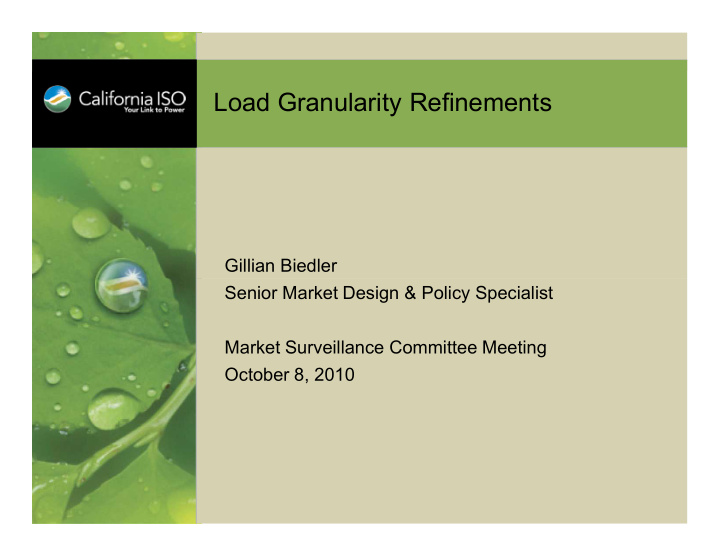



Load Granularity Refinements Gillian Biedler Senior Market Design & Policy Specialist Market Surveillance Committee Meeting October 8, 2010
Objectives for this discussion Background and context Additional benchmarking against other ISO/RTOs Stakeholder feedback Provide some analysis of price divergence Provide some analysis of price divergence Used CRR/PDR sub-LAPs in comparison to default LAPs Targeted benefits How might these benefits most efficiently be achieved? Questions for the MSC Slide 2
Background Load pricing design under the original MD02 filing was nodal Revised design filed with FERC in 2006 used 3 default LAPs LAPs September 21, 2006 Order LAP-level bidding, scheduling and settlement for load acceptable initially Increased granularity in Release 2, i.e. 3 years after start of the LMP market = April 1, 2012 Slide 3
Additional Benchmarking… Has FERC ordered load zone disaggregation in other ISOs or have those markets undertaken it on their own initiative? NYISO – directed to consider additional capacity zones, but not additional load zones but not additional load zones MISO & PJM – they leave load zone determination to their participants, and provide nodal optionality ISO-NE – on their own initiative, they attempted to split one load zone to align with a proposed capacity zone Slide 4
Stakeholder Feedback on the Issue Paper Analysis of costs as well as benefits Longer / delayed implementation timeline Analysis of convergence bidding and PDR data Efficacy of other market enhancements Information on disaggregation plans / mandates in other wholesale electricity markets Consideration of and coordination with state policy Slide 5
Average On-Peak Prices: default LAP – sub LAP (April ‘09 through August ‘10) SCE Northwest Low Desert High Desert SCE West SCE North Core (LA Basin) Stockton San Joaquin Sierra San Francisco (Bay Area) San Francisco (Bay Area) Subsidizing Subsidized South Bay (Bay Area) Sacramento Valley Peninsula (Bay Area) North Valley North Coast North Bay Los Padres Humboldt Geysers Fresno East Bay (Bay Area) Central Coast (12.00) (10.00) (8.00) (6.00) (4.00) (2.00) 0.00 2.00 4.00 6.00 8.00 Slide 6
How can we achieve the targeted benefits Targeted Default LAP Other Benefit Disaggregation Enhancements Physical load settles at a Information release, Accurate Price Signals more granular level convergence bidding Increased incentives PDR, Participating Load, Demand Response for demand response retail-level programs Consistent Settlement PDR and load zones at – n/a – of Load and PDR same geography Smaller zones + Sub-LAP CRRs in annual Improved Congestion consistency with load tiers 2,3 and Hedging settlement → accuracy monthly tiers 1,2 Transmission Investment – negligible – Largely policy-driven More accurate demand LDF improvement initiative, Improved DA solution clearing in the IFM convergence bidding Slide 7
In the view of the MSC… 1. How significant are the price differences? 2. Do the price differences merit LAP disaggregation? 2. Do the price differences merit LAP disaggregation? 3. How efficient is LAP disaggregation in achieving the targeted benefits relative to the other enhancements? Slide 8
Contact Information Dave Timson Gillian Biedler dtimson@caiso.com gbiedler@caiso.com Desk: 916-608-1134 Desk: 916-608-7203 Mobile: 916-802-4685 Mobile: 916-337-7485 Slide 9
Recommend
More recommend